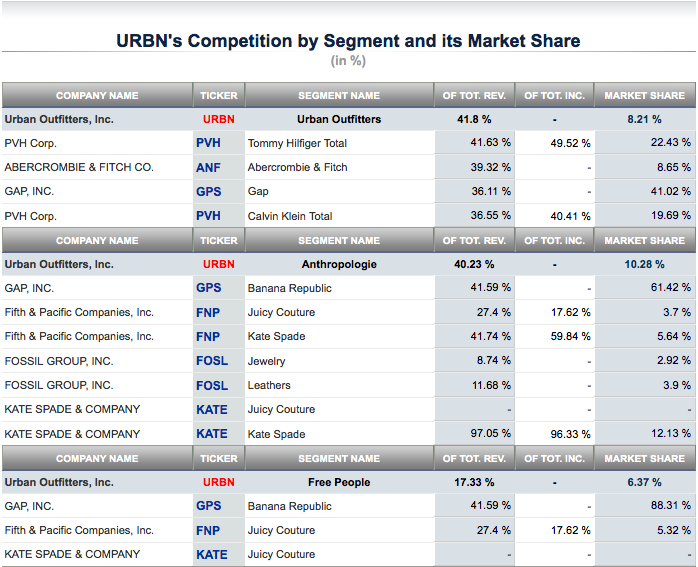Comparing the results to its competitors, Urban Outfitters Inc reported Total Revenue increase in the 3 quarter 2014 by 5.22 % year on year, while most of its competitors have experienced contraction in revenues by -0.08 %, recorded in the same quarter. Urban Outfitters’s Revenue rose by 5.22 % in III. Quarter (Oct. 30, 2014) year on year, to $814 million and advanced by 0.4 % sequentially.
Market Potential
Industry/Demand Trends
According to Statista.com,The United States’ apparel market is expected to grow from USD 225 billion in 2012 to USD 285 billion in 2025; a CAGR of two percent.
In 2014, the financial condition of retailers appears strong—and growing—with retailers having a more positive outlook on the upcoming holiday season as well as overall sales than even a year ago. Despite challenges related to technology adoption and the ability to buy anything anywhere, retailers are embracing change. They are making new investments in products, expanding their digital strategy and becoming more comfortable with social media as a tool for multiple facets of their business.
According to research conducted by Harris Poll, more than 8 in 10 retailers offer a positive view of their company’s current financial situation, describing it as healthy, much more so than last year. And, the majority offer a promising forecast for 2014 sales, growing across all channels, except catalog. In fact, more than 6 in 10 retailers (especially online only) expect at least a 6% increase in total sales for 2014, up significantly from last year.
Eighty-two percent of retailers say their company’s current financial condition is “healthy” or “very healthy” compared to only 70% who felt equally optimistic in 2013. Most believe revenue is growing from website and mobile sales.
Fifty-eight percent of retailers agree that brick-and-mortar-only stores will not survive in the future.
Nearly half of retailers (especially those with an online presence) believe that the death of the American mall is also inevitable. And rather, most believe one-stop shops like Walmart and Target will become the stores of the future. Along with adjusting to new technologies, most see these “one-stop shops” as one of the biggest threats to their retail success.
According to retailers, the two most disruptive factors to the business model include: adjusting to new technologies (5%) and the ability to get anything anywhere (6%).
When thinking strategically about the future, most retailers highlight the importance of investing in new product development, marketing, online presence and social media. But brick-and-mortar-only retailers and those with an online presence do not share the exact same priorities. While both businesses plan to focus on marketing and new products, combined and online-only retailers emphasize both of these tactics much more. And, brick-and-mortar-only businesses feel that expanding their physical footprint is a much higher priority than investing in their online presence, mobile technology or social media. Most retailers also speculate that U.S. consumer’s value more than ever products that are “Made in America.”
The majority of retailers believe that online and mobile channels support—and do not erode— brick-and-mortar channels. The two channels are perceived as having different uses, different goals and different benefits (convenience for online/mobile and personal connection for brick-and-mortar). Today, on average, retailers estimate that about 10% of their sales are generated online, and that in 1-3 years from now, this figure will rise to 13% overall (or a growth of 30% in the near term).
Even though today only about 6% of retail sales (on average) are generated through a mobile channel, more than 8 in 10 retailers say that having mobile apps represent a key advantage over the competition. Significant sales growth in the mobile channel is predicted in the near term—from 6% overall today to 9% in the next 1-3 years (an increase of 50%). Many retailers (especially online only and combined) view this as a clear directive to focus their energy toward mobile. More than half of retailers (especially online only and combined) have taken active steps to improve their mobile technology (in particular, improving website design, conducting email campaigns and creating mobile apps), while about 1 in 4 brick-and-mortar-only retailers admit they have done nothing to date.
The majority of retailers recognize that social media plays an important role in brand awareness, promotions and customer loyalty. And, comfort and knowledge in the social media space appears to be on the rise from last year. In 2013, the majority of retailers classified themselves as “beginner” or “intermediate,” and today, the balance has shifted, and most retailers categorize themselves as “advanced” or “expert”. Despite this confidence, social media still brings with it a variety of challenges, including how to leverage it to drive sales.
Urban Outfitters Trends
Urban Outfitters increasingly uses highly effective marketing tools in their websites, mobile applications, catalogs, email campaigns and social media. The media is refreshed as frequently as daily to reflect the most cutting edge changes in fashion and culture. Urban Outfitters believes that highly visible store locations, broad merchandise selection and creative and visual presentation within their stores, websites and mobile applications are key enticements for customers to explore these channels and purchase merchandise. They are also active in social media and blogs including Facebook, Twitter, Pinterest, Instagram and their own mobile applications.
